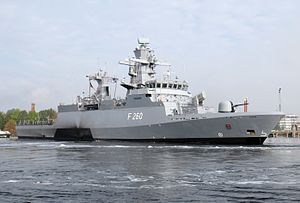German corvette Augsburg
 Braunschweig-class corvette
| |
| History | |
|---|---|
| Name | Augsburg |
| Namesake | Augsburg |
| Ordered | September 2017 |
| Builder | Lürssen-Werft, Bremen |
| Cost | €400 million |
| Commissioned | 13 July 2021 |
| Identification | Pennant number: F268 |
| Status | Ordered |
| General characteristics | |
| Type | Braunschweig-class corvette |
| Displacement | 1,840 tonnes (1,810 long tons) |
| Length | 89.12 m (292 ft 5 in) |
| Beam | 13.28 m (43 ft 7 in) |
| Draft | 3.4 m (11 ft 2 in) |
| Propulsion | 2 MTU 20V 1163 TB 93 diesel engines producing 14.8MW, driving two controllable-pitch propellers. |
| Speed | 26 knots (48 km/h; 30 mph) |
| Range | 4,000 nmi (7,400 km) at 15 kn (28 km/h; 17 mph)[1] |
| Endurance | 7 days; 21 days with tender |
| Complement | 65 : 1 commander, 10 officers, 16 chief petty officers, 38 enlisted |
| Sensors and processing systems | |
| Electronic warfare & decoys |
|
| Armament |
|
| Aircraft carried | Helicopter pad and hangar for two Saab Skeldar |
Augsburg (Pennant number F268) is the ninth ship of the Braunschweig-class corvettes of the German Navy.
Developments[edit]
The K130 Braunschweig class (sometimes Korvette 130) is Germany's newest class of ocean-going corvettes. Five ships have replaced the Gepard-class fast attack craft of the German Navy.
They feature reduced radar and infrared signatures ("stealth" beyond the Sachsen-class frigates) and will be equipped with two helicopter UAVs for remote sensing. The German Navy ordered a first batch of two UMS Skeldar V-200 systems for the use on the Braunschweig-class corvettes.[2] The hangar is too small for standard helicopters, but the pad is large enough for Sea Kings, Lynx, or NH-90s, the helicopters of the German Navy.
The German Navy ordered the RBS-15 Mk4 in advance, which will be a future development of the Mk3 with increased range —400 km (250 mi)— and a dual seeker for increased resistance to electronic countermeasures.[3] The RBS-15 Mk3 has the capability to engage land targets.[4]
In October 2016 it was announced that a second batch of five more frigates is to be procured from 2022 to 2025.[5] The decision was in response to NATO requirements expecting Germany to provide a total of four corvettes at the highest readiness level for littoral operations by 2018, and with only five corvettes just two can be provided.[6]
In September 2017, the German Navy commissioned the construction of five more corvettes in a consortium of North German shipyards. Lürssen are the main contractor in the production of the vessels. The contract is worth around 2 billion euros.[7][8] In April 2018, the German government announced the specific arrangements under which the five new K130s would be built.[9][10]
Construction and career[edit]
Augsburg was laid down on 13 July 2021[11] and is currently under construction by Lürssen-Werft in Bremen.
References[edit]
- ^ "Corvette Braunschweig Handed Over" (Press release). ThyssenKrupp AG. 30 January 2008. Retrieved 14 May 2015.
- ^ BAAINBw Procures New Helicopter Drones for the Navy, Baainbw, 27 September 2018, retrieved 2 March 2019.
- ^ "de:Neue Aufgaben der Marine mit moderner Ausrüstung" (in German). German Navy. 17 May 2004. Retrieved 14 May 2015.
- ^ German Navy K130 Corvettes Ready for Saab RBS-15 Mk3 Anti-Ship Missiles, Navy recognition, 8 June 2016.
- ^ "Fünf neue Korvetten für die Bundeswehr", Faz, 14 October 2016.
- ^ "German Navy to Get Five More K130 Braunschweig-class Corvettes", Navy recognition, 14 November 2016.
- ^ "Germany awards €2.4bln contract for five new K130 corvettes". Naval Today.
- ^ Kopp, Martin (13 September 2017). "Riesenauftrag von Bundeswehr: Blohm+Voss auf Jahre gerettet" (in German). Hamburger Abendblatt.
- ^ "Four Shipyards Agree to Build New German Corvettes". www.defense-aerospace.com. April 9, 2018.
- ^ "Wie Blohm+Voss vom Bau neuer Korvetten profitiert". Hamburger Abendblatt (in German). 6 April 2018.
- ^ @Com1DEUCorvSqn (July 13, 2021). "#Kiellegung der künftigen #Korvette AUGSBURG in #Wolgast" (Tweet) (in German). Retrieved 2021-07-13 – via Twitter.
